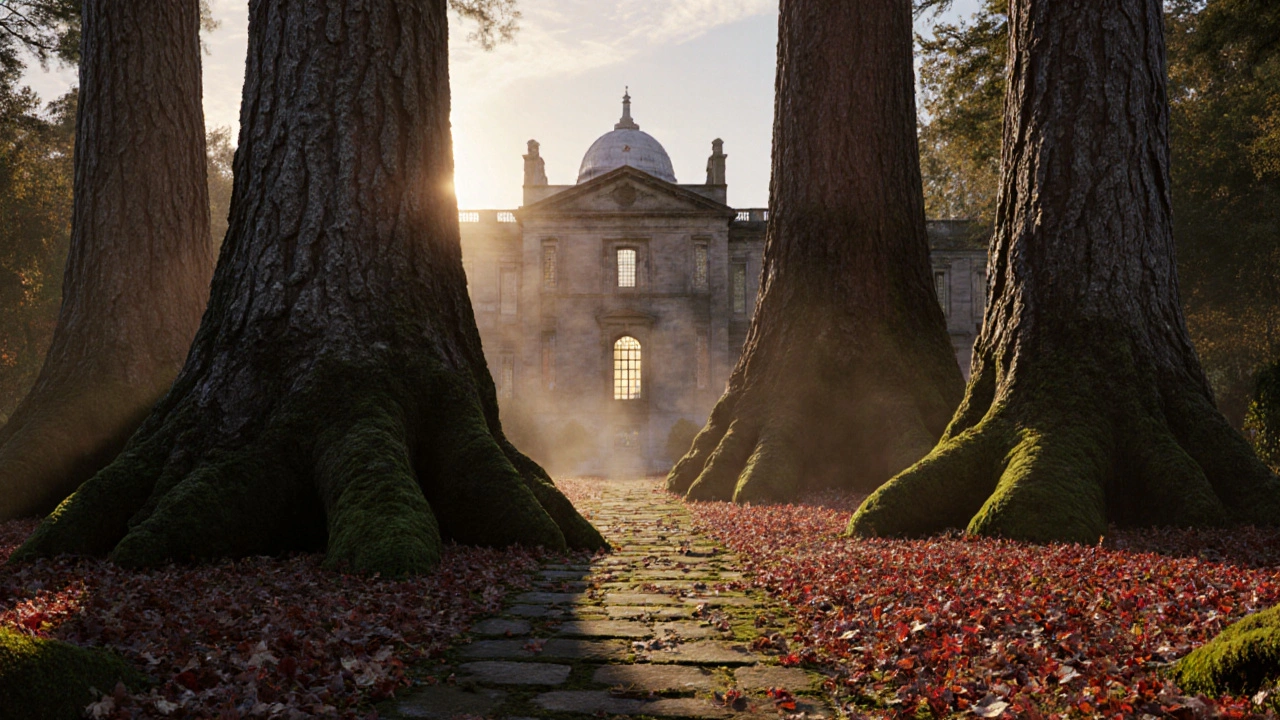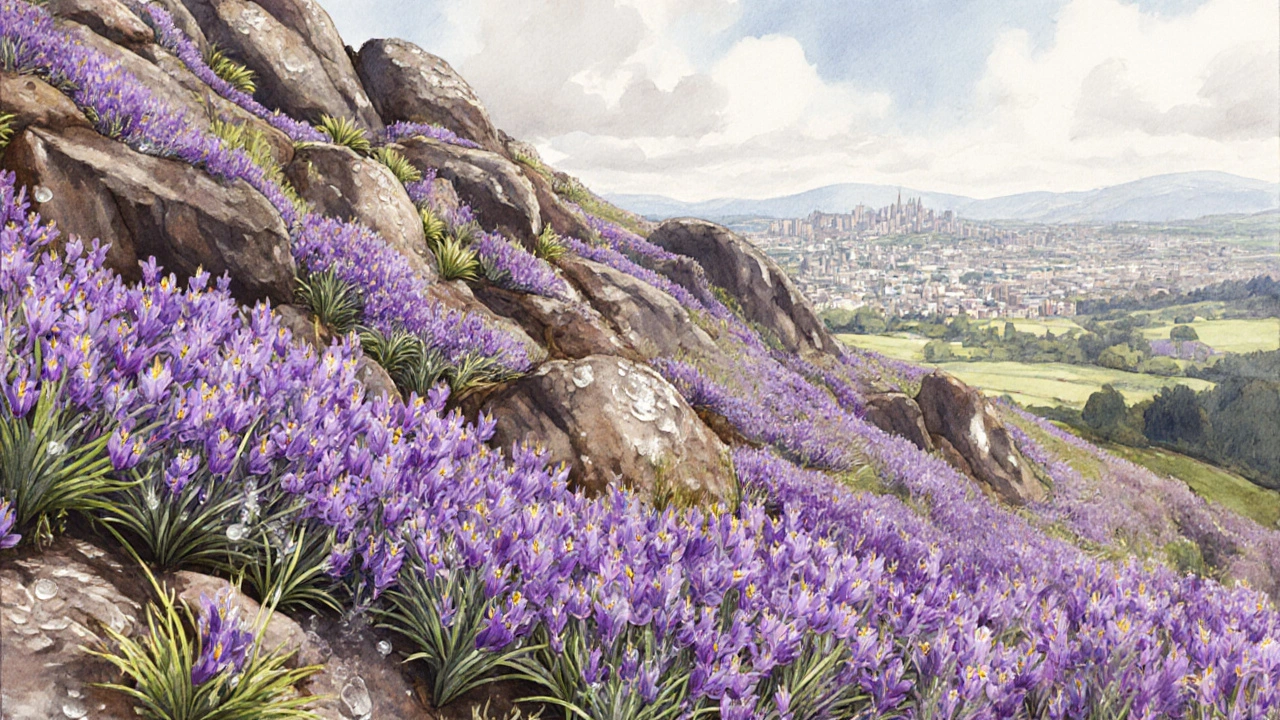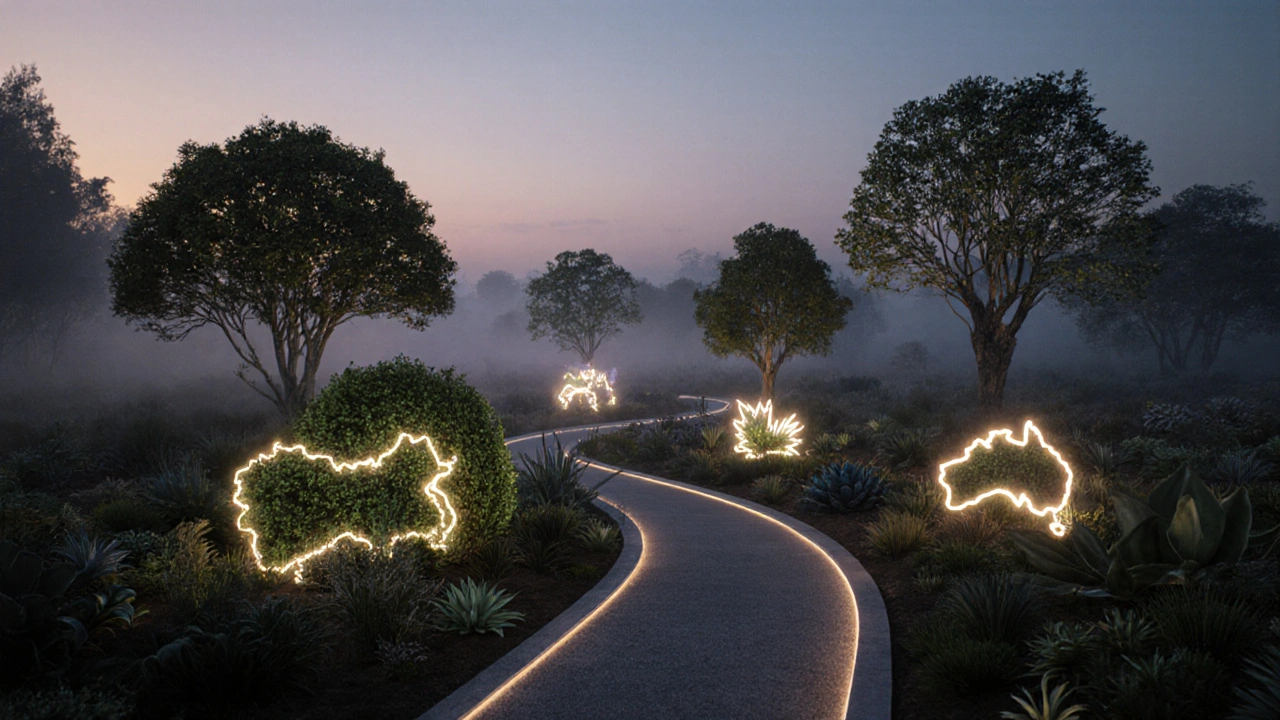
The Royal Botanic Garden Edinburgh isn’t just a pretty place to stroll. It’s one of the oldest and most scientifically important plant collections on Earth, with over 13,000 species from every continent except Antarctica. If you’re walking through its gates, you’re stepping into a living library that’s been growing since 1670 - and it’s open to everyone, free of charge.
What Makes the Plant Collection So Special?
Most city gardens focus on flowers and lawns. This one? It’s a global archive. The garden holds more than 3,000 species of rhododendrons - the largest collection in the world. You’ll find ancient cycads older than your great-grandparents, rare Himalayan blue poppies that only bloom under perfect conditions, and medicinal plants used in research labs across Europe.
The glasshouses aren’t just for show. The Temperate House alone holds over 2,000 species from places like South Africa’s fynbos region and the cloud forests of Costa Rica. These aren’t decorative plants. Scientists here study how climate change affects plant survival, and the garden is a key player in global conservation efforts. One in five plant species on Earth is threatened with extinction. This garden is helping keep some of them alive.
It’s not just about what’s inside. The garden’s seed bank stores over 2,500 species in cold storage, ready to be reintroduced into the wild if needed. That’s more than any other UK garden. The work here isn’t just about beauty - it’s about survival.
The Walking Routes: From Ancient Trees to Highland Hills
There are five main walking routes, each designed to show you something different. You don’t need a map. Just pick a path and let the plants guide you.
The Heritage Trail starts near the main entrance and winds past the oldest trees in the garden - some planted in the 1700s. The giant sequoias here are taller than a six-story building. Their bark is thick and fire-resistant, a trait that helped them survive wildfires in California. You’ll pass the original 1820s herbarium building, now a quiet reading room for botany students.
Head south along the Rock Garden Route, and you’ll climb through terraces of alpine plants. This area mimics the steep slopes of the Himalayas. Look for the cushion plants that grow low to the ground, hugging the soil to survive freezing winds. In spring, the entire hillside turns purple with gentians. Locals call it the ‘Purple Wave’ - and it’s the most photographed spot in the garden.
The Woodland Walk takes you under a canopy of beech, oak, and Japanese maple. In autumn, the leaves turn gold and crimson so thick they muffle footsteps. This is where you’ll find the garden’s most unusual resident: a 200-year-old Ginkgo biloba. It’s one of the oldest trees in Edinburgh, and it’s survived wars, pollution, and even a lightning strike in 1987.
For something quieter, try the Water Garden Loop. A series of ponds and streams flow through this section, fed by natural springs. Dragonflies hover over water lilies, and the sound of trickling water drowns out the city. This area was redesigned in 2020 to support native amphibians and insects. Frogs, newts, and even the rare great crested newt now breed here.
And then there’s the Global Flora Path. This is where the garden’s international work comes to life. You’ll walk through zones labeled by continent: Australia, South America, Southeast Asia. Each has plants that are culturally or economically vital - like tea bushes from China, coffee trees from Ethiopia, and quinoa from the Andes. Signs explain how these plants shaped human history. You’ll learn why the potato changed Europe’s population, or how rubber from Brazil built the modern car industry.

When to Visit for the Best Experience
Spring (April to June) is peak bloom season. The rhododendrons explode in color, and the tulip beds look like spilled paint. But it’s also the busiest. If you want quiet, go on a weekday morning. Locals know that Tuesdays and Wednesdays are empty before noon.
Summer brings long days and outdoor concerts. The garden hosts free jazz nights on Thursday evenings in July and August. Bring a blanket and sit under the chestnut trees. The air smells like lavender and damp earth.
Autumn is quieter but stunning. The maple trees turn fiery red, and the giant sequoias drop golden needles that crunch underfoot. It’s the best time for photography - soft light, fewer people, and rich colors.
Winter is quiet. The glasshouses stay warm, so you can still see tropical plants. The garden closes at 4 p.m. in December, but the paths are clear of snow. If you visit on a frosty morning, the ice on the ponds looks like stained glass.
What You Won’t Find Here
There are no gift shops selling cheap souvenirs. The main shop sells books on botany, local art, and organic seeds. No plastic water bottles are sold - only refill stations. The café uses compostable packaging and serves food from Scottish farms. Even the benches are made from recycled plastic.
You won’t find rollercoasters, playgrounds, or ice cream carts. This isn’t a theme park. It’s a place to slow down. To notice how a leaf curls, how moss grows on stone, how a bee moves from flower to flower. The garden doesn’t shout. It whispers - and if you listen, it teaches you something new.

How to Get There and What to Bring
The garden sits on the edge of Edinburgh’s Old Town, just a 15-minute walk from Waverley Station. Bus 12, 14, and 25 stop right outside. If you’re driving, parking is limited. Use the nearby NCP car park on Inverleith Row - it’s a five-minute walk.
Wear sturdy shoes. The paths are uneven in places, especially near the Rock Garden. Bring a light rain jacket - Edinburgh weather changes fast. A water bottle and a notebook are useful. Many visitors sketch plants or jot down names. The garden doesn’t have an app, but QR codes on signs link to detailed plant profiles.
Don’t bring dogs. Only guide animals are allowed. This isn’t a rule to be harsh - it’s to protect the plants. Dogs can trample rare seedlings or disturb nesting birds.
Why This Garden Matters Beyond Edinburgh
Plants don’t care about borders. The Royal Botanic Garden Edinburgh works with scientists in Nepal, Colombia, and Papua New Guinea. It’s helped restore forests destroyed by logging. It’s trained local botanists in countries with no universities. It’s shared seeds with gardens in Tokyo, Cape Town, and Chicago.
This isn’t just a tourist attraction. It’s a global hub for plant survival. And you can walk through it without paying a penny. That’s rare in today’s world.
When you leave, you won’t just remember the flowers. You’ll remember how quiet it felt. How the air smelled different. How something so small - a single leaf, a single seed - can hold the future of life on Earth.
Is the Royal Botanic Garden Edinburgh free to enter?
Yes, entry to the Royal Botanic Garden Edinburgh is completely free for all visitors. There’s no charge to walk the gardens, visit the glasshouses, or explore the plant collections. Donations are welcome but not required.
How long does it take to walk through the garden?
You can see the highlights in 2 to 3 hours, but many visitors spend half a day or more. If you walk all five routes slowly, read the signs, and rest in the quiet spots, plan for 4 to 5 hours. The garden is large - about 70 acres - so wear comfortable shoes.
Are dogs allowed in the Royal Botanic Garden Edinburgh?
No, dogs are not allowed, except for registered guide animals. This rule protects the rare plants and wildlife. Even well-behaved dogs can damage seedlings, disturb birds, or compact soil in sensitive areas. There are nearby parks where dogs are welcome if you’re traveling with one.
What’s the best time of year to visit?
Spring (April-June) offers the most color with rhododendrons and tulips in full bloom. Autumn (September-November) has stunning leaf color and fewer crowds. Summer has long days and outdoor events, while winter is peaceful and quiet, with tropical plants still thriving in the glasshouses. Each season has its own beauty.
Can I bring food and picnics?
Yes, you can bring your own food and picnic on the grassy areas near the main entrance or by the Water Garden. There are also picnic benches near the café. Just remember to take all trash with you - the garden is committed to zero waste.
Is the garden wheelchair accessible?
Most paths are wheelchair accessible, including the main routes and glasshouses. Some areas, like the Rock Garden, have steep slopes and uneven surfaces. Wheelchairs and mobility scooters are available to borrow for free at the main entrance - just ask at the information desk.
Comments (12)
-
Tina van Schelt November 11, 2025
The way the rhododendrons just explode in spring? Pure magic. I came in April and spent an hour just sitting by the Purple Wave, watching bees dive into those petals like they were swimming in liquid amethyst. No filter needed. No caption required. Just breathe.
And the way the air smells after rain? Like moss, earth, and old books. I’ve never felt more grounded anywhere else in the world.
Also, the fact that they don’t sell plastic bottles? Chef’s kiss. Someone’s doing it right.
PS: The Ginkgo biloba has a vibe. Like it’s seen empires rise and fall and just nodded.
PPS: Bring a notebook. You’ll want to write down every plant name. I did. And I still look at it three years later.
-
Ronak Khandelwal November 12, 2025
🌿 This garden isn’t just plants-it’s a love letter to the planet. 🌍
Every seed in that bank? A whisper of hope. Every ancient cycad? A living timeline. Every path? A meditation.
We think we’re saving nature. But nature? It’s saving us. Quietly. Gently. Without asking for applause.
Let’s stop treating green spaces like backdrops for selfies. Let’s treat them like sanctuaries. Because they are.
And yes-I cried a little by the Water Garden. No regrets. 🌊💧
-
Jeff Napier November 13, 2025Free? Yeah right. They’re just waiting for you to get addicted then charge you $50 for a QR code that tells you what a fern is. Also the ‘no dogs’ rule? That’s just to keep the elite quiet. Who lets a plant collection have more power than a person? This is soft fascism disguised as serenity. And the ‘zero waste’ thing? They’re just using compostable packaging so they can sell you $12 herbal tea in a leaf cup. I’m onto them.
-
Sibusiso Ernest Masilela November 14, 2025
You call this a ‘garden’? Please. This is a museum of colonial botanical looting dressed up in Scottish tweed. Those Himalayan poppies? Stolen from Nepal. The quinoa? Plucked from Andean soil. The ‘free entry’? A PR stunt to make you feel virtuous while they hoard genetic material for Big Pharma.
And don’t get me started on the ‘global hub’ nonsense. They don’t train botanists-they extract. They don’t preserve-they curate. And you? You’re just a tourist with a camera and a guilty conscience.
Real conservation? It’s not in Edinburgh. It’s in the villages they never mention. The ones they never pay.
Stop applauding. Start paying.
-
Daniel Kennedy November 14, 2025
Sibusiso has a point about extraction-but he’s missing the bigger picture. The RBGE isn’t perfect, but it’s one of the few places on Earth actively giving back. They’ve sent seeds to 47 countries. They’ve trained over 200 botanists from the Global South. They’ve restored forests in Papua New Guinea using local knowledge, not just Western science.
Yes, colonial history is part of this place. But so is repair. So is humility. So is action.
And yes, the no-dogs rule? Necessary. That’s not elitism-that’s responsibility. A single dog can destroy a rare seedling that took 20 years to grow.
Don’t hate the garden. Help it. Volunteer. Donate. Learn. That’s how you honor it.
-
Taylor Hayes November 16, 2025
Jeff, I get where you’re coming from-there’s a lot of performative virtue out there. But this place? It’s different.
I used to think gardens were just pretty backdrops. Then I came here after my dad passed. I sat under that 200-year-old Ginkgo for two hours. Didn’t cry. Didn’t think. Just listened.
And you know what? The tree didn’t care if I was sad or happy. It just… was. And that was enough.
Maybe we don’t need to fix everything. Maybe we just need to be near things that outlive us.
Thank you, RBGE, for being that place.
-
Sanjay Mittal November 17, 2025
For anyone planning a visit: the Rock Garden is best at 8am in late May. The gentians are fully open, the light is golden, and you’ll have it to yourself. The Water Garden is quietest after 5pm in October-dragonflies still active, no tourists, just the sound of water and wind.
Also, the herbarium reading room? Ask at the desk. They’ll let you see a 1780s pressed specimen of a Himalayan blue poppy. It’s like holding a piece of history. No photos allowed, but you’ll remember it forever.
And yes-bring a jacket. Even in summer, the wind off the Pentland Hills bites.
-
Mike Zhong November 18, 2025
They say ‘plants don’t care about borders’-but they do. Every seed they collect, every species they catalog, every ‘global hub’ claim-it’s all built on the same imperial logic that shipped opium from India and rubber from Brazil. The only difference? Now they call it ‘conservation’ instead of ‘exploitation.’
They don’t want to save the world. They want to own the blueprint.
And you? You’re just the audience for their botanical theater.
-
Jamie Roman November 18, 2025
I’ve been coming here for 12 years. Started as a grad student in botany, now I’m a high school teacher. I bring my classes every spring.
One kid, 14 years old, quiet kid, never spoke up-came up to me after a visit and said, ‘I didn’t know plants could have feelings.’ I didn’t know what to say. So I just nodded.
Turns out he started a school garden. Now he’s studying environmental science. I didn’t teach him anything. The garden did.
That’s why I keep coming back. Not for the rhododendrons. Not for the glasshouses. For the quiet moments when someone, somewhere, realizes they’re part of something bigger.
And yeah-I still bring a notebook. Still write down every name. Still get lost in the Woodland Walk. Still cry a little when the light hits the maple leaves just right.
It’s not a garden. It’s a home.
-
Salomi Cummingham November 20, 2025
That moment when you turn a corner and there it is-the Himalayan blue poppy, glowing like a piece of the sky fell to earth?
I’ve stood there three times. Each time, I held my breath. Each time, I felt like I’d been let in on a secret the world forgot to tell.
And the benches? Made from recycled plastic? Genius. Because even the way we sit here is part of the story.
I came here after my divorce. Sat on a bench for three hours. Didn’t cry. Didn’t think. Just watched a snail climb a fern. Took me three hours to realize I was smiling.
They don’t sell healing here.
They just let you find it.
And for that? I’ll never stop coming.
-
Johnathan Rhyne November 21, 2025You say ‘no gift shops selling cheap souvenirs’-but you’re missing the point. The shop sells ‘organic seeds’ and ‘local art’? That’s just premium branding. You’re paying for the illusion of ethics. And ‘compostable packaging’? That’s still packaging. And if you’re going to be this preachy about plastic, why not ban all packaging? Why not make people carry their own bowls? Hypocrites. Also, ‘no dogs’? That’s not protection-that’s control. And the ‘free entry’? That’s how you lure in the masses so you can monetize their guilt later.
-
Daniel Kennedy November 22, 2025
Johnathan-I hear you. And you’re right to question the aesthetics of ‘greenwashing.’ But here’s the thing: the garden doesn’t sell anything you don’t need. No plastic trinkets. No overpriced t-shirts. No branded coffee mugs.
Their shop? Books on plant taxonomy. Handmade ceramic pots from local potters. Seeds you can actually grow. That’s not branding. That’s integrity.
And yes, they use compostable packaging. Because even that’s better than plastic. And they’re working on eliminating it entirely.
They’re not perfect. But they’re trying. And that’s more than most institutions do.
Don’t dismiss the effort because the packaging isn’t zero. Celebrate that it’s moving in the right direction.
